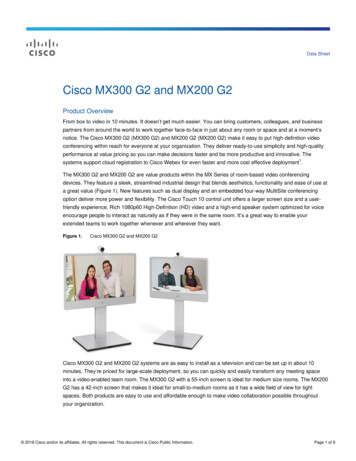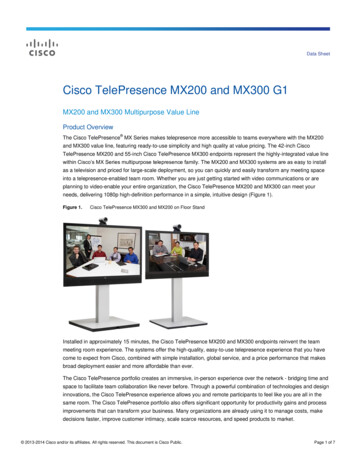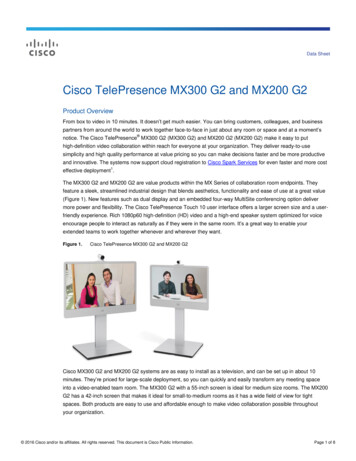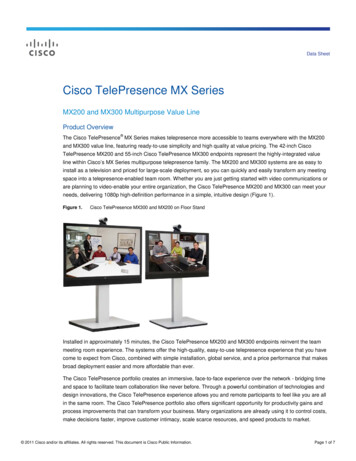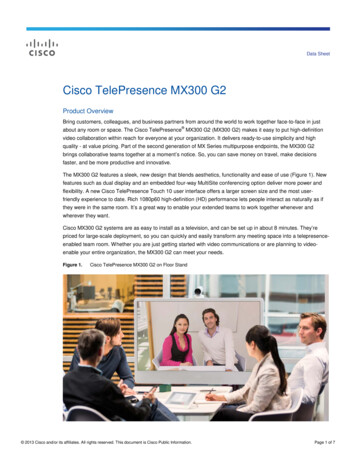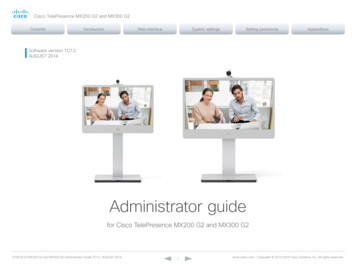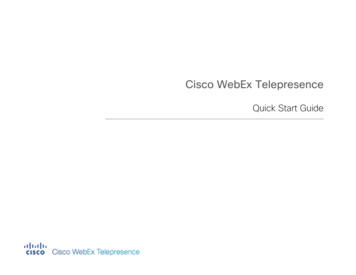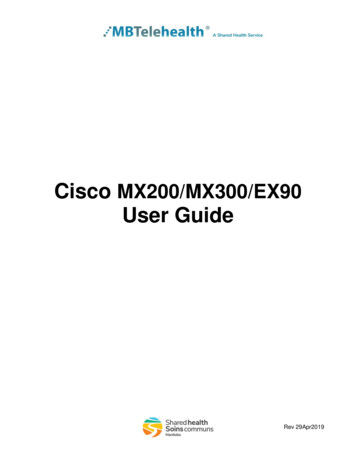
Transcription
Cisco MX200/MX300/EX90User GuideRev 29Apr2019
MBTelehealth – Cisco MX200/MX300/EX90 User GuideTable of Contents1.0OVERVIEW . 32.0GENERAL USE . 52.1How to Use the Touch Screen . 52.2Set Up and Use of Videoconference Solution . 52.3Self-view . 52.4Camera Controls . 62.5Microphone . 72.6Site to Site Calls . 82.6.1 Making video calls to a MBT Site . 82.6.2 Making video calls to a site outside the MBT network . 92.6.3 Far End Control (Site to Site) . 92.7Multi-Site Event Calls (MCU) .102.7.1 Far End Control (Multi-Site) .102.8Receiving Video Calls .102.9Volume .112.10Participant List .113.0SHARING CONTENT – PERIPHERAL DEVICES .124.04.14.2TROUBLESHOOTING .14Audio Issues .14Video Issues .145.0ADDITIONAL TRAINING INFORMATION .156.0VIDEOCONFERENCING ETIQUETTE .15Page 2 of 15
MBTelehealth – Cisco MX200/MX300/EX90 User Guide1.0OVERVIEWThis user guide will provide you with an overview of the Cisco MX200/MX300videoconference solution and the knowledge to setup and use the equipment.The main components of the Cisco MX200/MX300 videoconference solution are theCamera, Codec, Ethernet Cable, Microphone, Screen/Monitor, Touch pad and Router.Some units may also have a cart.Screen/MonitorCameraCodecTouch padMicrophoneRouterPage 3 of 15
MBTelehealth – Cisco MX200/MX300/EX90 User Guide1. Camera - The built-in camera is a high quality imaging device which transmitsimages to the screen/monitor.2. Codec - The codec is the central part of the videoconferencing equipment. The maintask of the codec is the compression of outgoing video, audio and data, thedecompression of the incoming information and the transmission of this informationbetween endpoints. The name codec comes from a combination of the two wordscompression and decompression.3. Microphone - The table microphone is designed to be located on a flat surface infront of the participant. The microphone cable should always face towards thevideoconferencing system. The system will automatically equalize sound levels.4. Screen/Monitor - The screen/monitor displays the far end or the near end imageand content as selected by the user.5. Router - When connected to an MBTelehealth drop, the Router provides a secureconnection back to the MBTelehealth network.6. Touch pad- The touch pad is used to place calls, adjust the volume, navigatescreens and select options. It controls all functions of the videoconferencingequipment. The equipment will not function without the touch pad.MX200/MX300TouchpadThe Cisco MX200/300TouchScreenThe Meetings, Messages, and Help Desk items are not currently used at MBTelehealth.Page 4 of 15
MBTelehealth – Cisco MX200/MX300/EX90 User Guide2.02.1GENERAL USEHow to Use the Touch ScreenTap the touch screento wake up the system.2.2Tap a button to activateits function.Scroll in lists using an up ordown sliding motion with yourfinger.Set Up and Use of Videoconference Solution1. Wake the codec by tapping the touch screen and turn on the videoscreen/monitor. In a few seconds you will see the home screen.If the Ethernet cable is connected correctly, you will see a green VPNlight on the front of the Router.2. Place the microphone on the table in front of the participants.2.3Self-viewBefore the meeting starts we recommend that you check the self-view. The self-viewdisplays an image of your camera view on screen and shows you what you will besending to the other site.Tap Self-viewTo move the self-view to adifferent location, press andhold it with your finger untilit turns blue and drag it toone of the positions asindicated on the screen.The position of theselfview will appear asshown above.The self-view itself willbe shown to you aspicture-in-picture (PIP)on your screen/monitor.If required, you can showselview as full screen. Tapthe selfview box and tapMaximize. To turn off fullscreen, tap inside the boxand tap Minimize.Page 5 of 15
MBTelehealth – Cisco MX200/MX300/EX90 User Guide2.4 Camera ControlsThe camera can be controlled manually or by using Camera Presets.To adjust the camera manually:Tap Cameratoaccess the camera controls.Use the arrows to movethe camera to thedesired position and /to zoom in and out.Tap outside the menu toexit.To use camera presets:Camera presets are useful when images from many different camera positions andvideo sources are to be viewed by the far end site(s). Presets are used to switch camerapositions quickly and easily without having to manually move the camera.Tap Cameratoaccess the camerapresets.Tap the desired preset thatyou would like to display.Tap anywhere outside themenu to exit.Note: There are 3 standardpresets: Sign, participant,room.To add a new camera preset:Tap Self-viewif needed,to see the effects of your cameraadjustments.Tap Add new PresetTap Cameratoaccess the camera controls.Key in descriptive name.Use the arrows and zoom /- to adjust the camera todesired location.Tap Save to leave the menuputting changes into effect ortap Cancel to leave menu andundo any changes.Page 6 of 15
MBTelehealth – Cisco MX200/MX300/EX90 User GuideTo modify an existing preset:Camera presets will be set up and saved as part of equipment implementation but theremay be a need to change or resave presets.Tap Self-view, if needed,to see the effects of your cameraadjustments.Tap next to the preset tobe edited.Tap Cameratoaccess the camera controls.Use the arrows and zoom /- to adjust the camera.In the submenu tapUpdate to new position.If you need to delete apreset, tap remove.The MX200/MX300 is set up with three (3) Standard Presets:1. Sign - The first preset is of a sign with the sites name. This is an off screencamera view that allows users to move about the room without being on cameraand identifies the sites that are connected.2. Participant (Presenter/Provider/Patient) – This preset is a close up view of theperson or persons involved in the event. Whether it is the patient, provider or apresenter, when setting this preset, you want to ensure that the far sites are ablesee the person clearly.3. Room –Part of videoconference etiquette includes making the sites you areconnected to aware of everyone involved in the event. By setting a preset of theentire room, you can easily identify everyone in attendance and then switch backto preset number 2 as necessary. This preset is also helpful for question andanswer periods.2.5 MicrophoneTo mute/unmute the microphone: Tap Mic Offon the touch screen or on themicrophone itself. An onscreen indicator will appear when the microphone is off and thebutton on the microphone will change to red. Tap Mic Off again to unmute; the indicatorwill turn to green.Page 7 of 15
MBTelehealth – Cisco MX200/MX300/EX90 User Guide2.6 Site to Site Calls2.6.1Making video calls to a MBT SiteTap DialpadType in the 5 digit number for thesite/equipment that you areconnecting to (see Fig 1 below).Tap Call to connect.Tap Endto disconnect.Fig 1The 5 digit number can be found beside the VCU# on the Whiteboard, Clinic List orConfirmation reports in iScheduler.Use the ABC/123 to toggle back and forthbetween the keyboard and the dialpad.Frequently called sites/equipment:If you call the same sites from the same equipmentyou can save the contact to the favourites liston that equipment.The next time you need to call the site, look in thefavourites list to save you from locating and typing in the 5digit number.Page 8 of 15
MBTelehealth – Cisco MX200/MX300/EX90 User Guide2.6.2Making video calls to a site outside the MBT networkTap DialpadType the number that you have beenprovided.Tap Call to connect.Tap Endto disconnect.Tap ABC/123 to toggle backand forth between the keyboard and dialpad.2.6.3Far End Control (Site to Site)Taking Far End Camera Control allows you to move the camera at the far end site.Before taking far end camera control, always request permission first and explain whyyou are taking control. You may need to take far end camera control if: There is an unskilled operator at the far endThe operator requests that you take controlIf the operator isn’t able to facilitate the event at their endTo use far end camera control during a Site to Site call:Tap the participant box.Adjust the camera as requiredusing the arrows and zoom /-.Tap Camera.Tap Back to exit the menu.Page 9 of 15
MBTelehealth – Cisco MX200/MX300/EX90 User GuideIf you are on the home screen and you do not seethe participant box in the middle of the touch screen,tap the “orange” site banner at the top of the screen.2.7Multi-Site Event Calls (MCU) 2.7.1Multi-site (MCU) sessions will be connected to the event automatically at thescheduled start time.If you are registered for the event and it is already in progress and you are NOTconnected, you can join by using the connection information shown on theWhiteboard.MCU calls will be automatically disconnected at the scheduled end time.Far End Control (Multi-Site)This is the default layout you will seeon your screen, unless another optionwas chosen by the host/presenterwhen the event was booked (seebelow).The number indicateshow many more sitesare connected but arenot shown on thescreen.These are the layoutoptions available whenan event is booked.2.8Receiving Video CallsYour Cisco MX200/MX300 has been configured to automatically accept all incomingconnection requests. This means that both site to site connections initiated by anothersite and multi-site connections will be automatically connected.You will hear a dial tone that indicates there is an incoming call and your microphone willautomatically mute so that the connecting site cannot overhear what you arePage 10 of 15
MBTelehealth – Cisco MX200/MX300/EX90 User Guidediscussing. Once the connection is made, you will need to unmute your microphoneso that the other site(s) can hear you.If you do not want to accept an incoming call, press decline if the option is available.Most systems have been configured to automatically accept calls.If you are participating in a multi-site event (3 or more participating sites) you willbe automatically connected by the MBTelehealth service desk.Do not attempt to connect to another location.2.9 Volume.Tap and drag your finger up and downon the volume control to increase ordecrease the volume.2.10 Participant ListParticipant List – For information onlyTap the dot that is not shown in white just above the row of buttons at the bottom of thetouch pad to invoke a list of participants (a). Alternatively, swipe your finger horizontallyacross the screen (b). During a multi-site call you will see your site as well as theservice desk. During a site-to-site call you will see your site andthe other site listed. There are layout options that may be visible(equal, prominent, overlay, single) but they are not currently in use.Tap the other dot to return to the initial state.Page 11 of 15
MBTelehealth – Cisco MX200/MX300/EX90 User Guide3.0SHARING CONTENT – PERIPHERAL DEVICESThe MX200/MX300 allows for users to display additional video sources through a singleDVI port connection.The instructions below show users how to connect a Laptop or Patient cameraindividually and how to manage a set up where both may be required at different times.To connect a laptop to the videoconferencing equipment:1. Using a VGA/ DVI cable, connect the DVI end to theDVI-I in at the back of the codec.2. Connect the VGA end to the matching port on the laptop.3. Turn the laptop on.To start your presentation:Tap Presentation and tapPresent. Tap Stop Presentingwhen finished to return tomain camera view.Tap Layout to see thelayout optionsSelect your preferredlayout by tapping it.(Equal, Prominent,Overlay, Single)If you see the message “PC Not Connected” do the following:on the laptop keyboard, press the Function key (Fn) and theappropriate F key (often F4, F5, F8 or F10) simultaneously. Adisplay options menu will appear, select the option to displayon both. .To connect a Patient Camera to the videoconferencing equipment:Using a DVI/ DVI cable, connect one end of the DVI cable to the back ofthe codec and the other to the matching port on the GlobalMedTotalExam HD Patient Camera.Tap Presentation (a) and tapPresent. You should now seethe Patient Camera imagedisplayed on the videoconference monitor. Scrollhorizontally (b) to locate thepresentation source if required.Page 12 of 15
MBTelehealth – Cisco MX200/MX300/EX90 User Guide To display the PC/Patient Camera full screen for your site tap Selfviewand tap Maximize. Tap Minimize to return to the previous view.You can use your presets at any time by tapping Camera and tapping thedesired Preset.When both a Laptop and a Patient Camera will be used with the videoconferencingequipment:The instructions identified above will still be relevant but the addition of a Male to FemaleDVI cable will be added to the solution set up. The addition of this cable will allow foreasy access and switching between the two peripheral devices.The cable will be connected to the back of the codec with the Female end accessible foreasy connection of a DVI/VGA cable for laptops and a DVI/DVI cable for the patientcamera.Turn on the Patient Camera.Tap Presentation and tap Present.Scroll horizontally to locate thepresentation source if required.Dual Video (Not currently in Use)The MX200/MX300 also supports dual video streams. With dual video stream you canview two different live video streams simultaneously; the main video and one additionalsource. This could for example be both a PC presentation and the person who gives thepresentation.If the connecting video system does not support dual video stream, no second videostream will be established for this system and the PC presentation will be shown as themain video.Page 13 of 15
MBTelehealth – Cisco MX200/MX300/EX90 User Guide4.0TROUBLESHOOTING4.1 Audio IssuesIssuePossible Cause(s)Far-end site unable to hearyouResolution Your microphone is muted Un-mute your microphone Your microphone is obstructed ortoo far from the person speaking Check microphone and ensure itpoints towards the personspeaking Try to instruct far site to un-mutetheir microphone Increase the volume on themonitor and/or the codecUnable to hear far-end site Microphone is muted at far end site Near end monitor and/or codecVolume is too lowAudio distortion from farend site Far site monitor volume is too high Turn down the volume on the farend monitorEcho or distortion at nearend when people speaking Far-end microphone is situated tooclose to the monitor Speaker/volume is too high on farend monitor Ask to move microphone furtheraway from monitor Ask far-end site to turn volumedown on their monitor.4.2 Video IssuesPossible Cause(s)ResolutionPicture is blank on themonitorIssue System has gone into “sleep” mode Monitor has been powered off Monitor input has changedNear-end site unable tohear or see the picturefrom far-end peripheral Proper input has not been selected Cables are not properly connected Tap the Touch pad and thesystem will reactivate in normalmode. Turn the monitor on Check to see if the monitorinput has been changed (usingthe select or input button onthe TV Monitor) Check for correct inputselection on remote control Check that output from laptoppatient camera, VCR, ordocument camera areconnected properlyIf you are experiencing any problems with the videoconferencingequipment or have any questions, please contact the Service Desk forassistance:Service Desk 204-940-8500 Option 4or toll-free 1-866-999-9698 Option 4Page 14 of 15
MBTelehealth – Cisco MX200/MX300/EX90 User Guide5.0ADDITIONAL TRAINING INFORMATIONFor additional information on videoconference equipment visit www.mbtelehealth.ca orcontact your Facilitator-eHealth Solutions.6.0VIDEOCONFERENCING ETIQUETTEThe following tips on videoconferencing etiquette will help prepare you for a successfulsession: Assume that people can see and hear you as the Camera and Microphone arealways “Live”. Identify yourself and anyone else in the room to the client. Speak directly towards the microphone and use your normal speaking voice. Try to avoid a lot of movement or shuffling of papers as this may affect the quality ofthe sound transmission. Due to the audio delay, pause for clients to ask or answer questions or when theyhave comments. Always ensure there are no further questions and that the client is aware of follow-upinstructions before signing off.Page 15 of 15
MBTelehealth - Cisco MX200/MX300/EX90 User Guide Page 4 of 15 1. Camera - The built-in camera is a high quality imaging device which transmits images to the screen/monitor. 2. Codec - The codec is the central part of the videoconferencing equipment. The main task of the codec is the compression of outgoing video, audio and data, the
